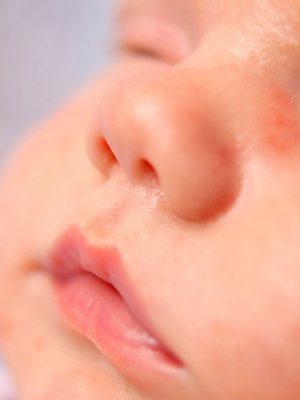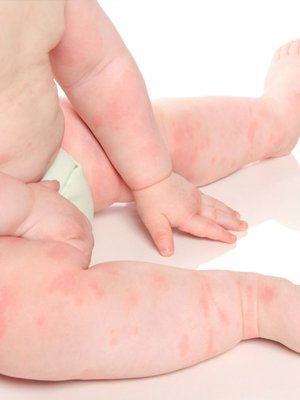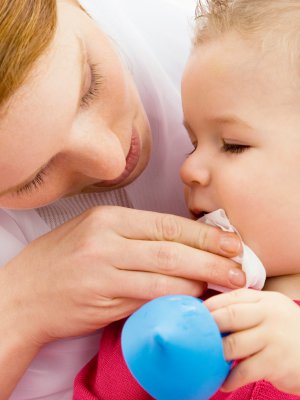DIARRHEA

We believe breast milk is the best food for infants. When in consultation with their healthcare professional, mothers and families find that optimal breastfeeding is not possible due to their infant’s medical condition, formulas for special medical purposes play a vital role in providing essential nutrients to infants. We have a global commitment to market breast-milk substitutes responsibly.
Diarrhea is defined as the passage of three or more unformed or liquid stools per day, lasting up to 14 days.1 A change in stool consistency rather than stool number is more indicative of diarrhea in infants.1 Diarrhea is generally obvious to identify, however, the following cases indicate a healthy infant and should not be confused with diarrhea:1,2
· Normal or healthy newborn stools are soft and loose
· Newborn babies pass stools frequently, sometimes after every feeding
· Breastfed infants often have pasty stools
What causes diarrhea in infants?
In infants worldwide, diarrhea is usually caused by an infection from a virus, e.g. Rotavirus and Norovirus, or bacteria, e.g. Campylobacter or Salmonella.3 Other causes of infant diarrhea include parasites, a reaction to a medicine, or a rare disease, such as cystic fibrosis2. In either case, diarrhea may also be accompanied by vomiting,1 which may increase the risk of dehydration.1 Dehydration is the main risk associated with diarrhea, therefore it is important to ensure that infants remain hydrated.

Diarrhea as a symptom of Cow’s Milk Protein Allergy
Diarrhea is the most common gastrointestinal symptom related to Cow’s Milk Protein Allergy (CMPA) and affects more than half of all children with CMPA.4,5,6
The majority of infants affected with CMPA have at least two symptoms affecting at least two different organ systems.7,8 If, in addition to diarrhea, your patient shows any of the signs and symptoms that can be related to CMPA4 (see below), you can use the CoMiSS® tool10 to score the combination of their symptoms and assess the likelihood of CMPA.
Signs and symptoms related to CMPA4
· Gastrointestinal/Digestive: Vomiting, reflux/regurgitation, refusal to feed
· Respiratory: Chronic cough, sneezing, wheezing, runny nose
· Skin: Rash, atopic dermatitis, urticaria, angioedema
· General: Failure to thrive, anaphylaxis, insomnia, inconsolable crying
How to score this symptom with the CoMiSS® tool
· The CoMiSS® tool uses the well-established Bristol stool scale10 to evaluate stool consistency
· Diarrhea should only be scored if it lasts for at least one week
· In addition to the stool score, if any of the following signs or symptoms related to CMPA are also present, they should also be given a score using the CoMiSS® tool. These include crying, regurgitation, skin (atopic dermatitis and urticaria) and respiratory symptoms
CoMiSS® awareness tool
The Cow’s Milk-related Symptom Score (CoMiSS)® is a simple, fast and easy-to-use awareness tool designed to help you more easily recognise the signs and symptoms that can be cow’s milk-related in infants and young children.

If you suspect your patient is suffering from symptoms that may be suggestive of CMPA, use the CoMiSS® tool to score and assess the likelihood of CMPA.
OTHER SYMPTOMS OF COW'S MILK PROTEIN ALLERGY
|
References |
|
1. WHO. 2013. Diarrhoeal disease factsheet No.330. http://www.who.int/mediacentre/factsheets/fs330/en/ (Accessed April 2016) 2. MedlinePlus. Diarrhoea in Infants https://www.nlm.nih.gov/medlineplus/ ency/patientinstructions/000691.htm (Accessed April 2016) 3. Guarino A., et al. JPGN 2014;59:132–152 4. Koletzko S., et al. J Pediatr Gastroenterol Nutr. 2012;55(2):221–9 5. Hill D., et al. J Pediatr. 1986;109:270–6 6. Iacono G., et al. N Engl J Med. 1989;339:1100–4 7. Lifschitz C. and Szajewska H. Eur J Pediatr. 2015;174:141–50 8. Høst A. Pediatr Allergy Immunol. 1994;5:1–36 9. Vandenplas Y., et al. Acta Paed. 2015;104:334–9 10. Lewis S. and Heaton K. Scand J Gastroenterol. 1997;32(9):920–4 |















